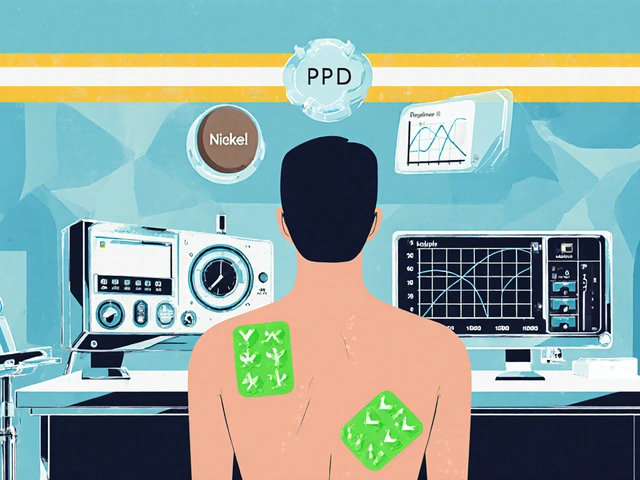
Hair Loss Progression Estimator
Track Your Hair Health Progression
Estimate how your hair might change over time based on key factors from the article. Results are for educational purposes only.
Quick Takeaways
- Hair naturally thins after 30, but patterns differ by genetics and health.
- Androgenetic alopecia and telogen effluvium are the two most common age‑related types.
- Nutrition, stress control, and scalp care can slow progression.
- Topical minoxidil, oral finasteride, and platelet‑rich plasma are evidence‑backed medical options.
- See a dermatologist if you notice sudden shedding or scalp irritation.
As the years add up, many people wonder why their hair looks finer and what they can actually do about it. The good news is that most age‑related changes are predictable, and there are clear steps you can take to keep your strands healthier for longer.
Hair loss is a gradual reduction in the number of active hair follicles, often resulting in thinner hair or visible balding. While aging accelerates this process, the underlying mechanisms are usually the same as in younger adults: hormonal shifts, genetics, and lifestyle factors.
Understanding How Aging Affects Your Scalp
When you hit your late twenties or early thirties, the hair‑growth cycle begins to change. The anagen (growth) phase shortens, while the telogen (rest) phase lengthens. This means each strand spends less time growing and more time dormant, leading to an overall thinner appearance.
Two conditions dominate the conversation:
- Androgenetic alopecia - often called “pattern baldness,” it’s driven by the hormone dihydrotestosterone (DHT) shrinking hair follicles.
- Telogen effluvium - a temporary shedding phase triggered by stress, illness, or nutritional dips.
Common Age‑Related Hair‑Loss Types
- Androgenetic alopecia: Starts at the hairline or crown, follows a predictable pattern, and worsens with age.
- Telogen effluvium: Sudden, diffuse thinning that can last a few months.
- Diffuse alopecia: Uniform thinning across the scalp, often linked to thyroid or iron deficiencies.
- Frontal fibrosing alopecia: A scarring type that mainly affects women over 50.

Key Triggers to Watch For
Even if genetics set the stage, several external factors can tip the balance:
- Hormonal changes: Declining estrogen in women and rising DHT in men accelerate follicle miniaturization.
- Nutrition: Low iron, zinc, or vitamin D levels correlate with weaker hair shafts.
- Stress: Chronic cortisol spikes push more follicles into the telogen phase.
- Medications: Blood thinners, beta‑blockers, and some antidepressants list hair loss as a side effect.
- Scalp health: Excess sebum or fungal overgrowth can block follicle openings.
How to Manage Age‑Related Thinning
Lifestyle Tweaks
Before reaching for a prescription, tighten up the basics:
- Balanced diet: Aim for 1.8 g protein/kg body weight daily, include leafy greens for iron, and snack on nuts for zinc.
- Stress control: Practice mindfulness, yoga, or short daily walks to keep cortisol in check.
- Gentle hair care: Use sulfate‑free shampoos, avoid tight ponytails, and let hair dry naturally when possible.
- Scalp stimulation: Light scalp massage for 5 minutes each night improves blood flow.
Medical Options with Proven Results
When lifestyle changes aren’t enough, these treatments have the strongest data behind them:
| Treatment | How It Works | Typical Use | Evidence Rating |
|---|---|---|---|
| Minoxidil (2%/5%) | Vasodilator that prolongs anagen phase | Topical, twice daily | Strong (FDA‑approved) |
| Finasteride (1 mg) | DHT blocker (5‑α‑reductase inhibitor) | Oral, daily | Strong (clinical trials) |
| Platelet‑Rich Plasma (PRP) | Growth‑factor injection to revitalize follicles | 3‑month intervals, 3‑4 sessions | Moderate (growing evidence) |
| Low‑Level Laser Therapy (LLLT) | Red light stimulates cellular activity | Device use 3‑times/week | Moderate (meta‑analysis) |
| Hair Transplant (FUE/FUT) | Moves healthy follicles to balding zones | Surgical, permanent | Strong (high success rates) |
Pick the option that matches your budget, tolerance for medication, and desired speed of results. Many dermatologists start patients on minoxidil and finasteride together for synergistic effect.
Non‑Medical Alternatives
- Essential oils: Rosemary or peppermint oil diluted in carrier oil shows modest increase in hair‑density scores.
- Supplements: Biotin (5 mg) and marine‑derived omega‑3s can support keratin production.
- Hair fibers: Cosmetic powders cling to existing hair, offering instant camouflage.
When to Seek Professional Help
Sudden patches, itchy scalp, or visible inflammation warrant a dermatologist’s assessment. They may run blood tests for thyroid, iron, and vitamin D, then tailor a treatment plan.
Checklist: Your Personal Hair‑Age Plan
- Track shedding: Count hairs on your brush weekly.
- Get blood work: Check ferritin, vitamin D, thyroid.
- Adopt a scalp‑friendly routine: mild shampoo, no tight styles.
- Start a proven treatment: minoxidil or finasteride, based on sex and tolerance.
- Schedule a follow‑up: Re‑evaluate after 3‑4 months.
Frequently Asked Questions
Can I stop hair loss completely?
You can’t guarantee 100 % prevention, but early intervention with proven treatments can halt most progression and even regrow some follicles.
Is it safe for women to take finasteride?
Finasteride is FDA‑approved for men only. Women, especially of child‑bearing age, should avoid it and discuss alternatives like low‑dose oral spironolactone with a doctor.
How long before I see results from minoxidil?
Most users notice reduced shedding after 8‑12 weeks, with visible thickening typically appearing around the 6‑month mark.
Do supplements actually help?
If you’re deficient, correcting the shortfall can improve hair health. In well‑nutrient‑replete individuals, the benefit is modest.
Is laser therapy safe for older skin?
LLLT uses low‑energy light, so it’s gentle on mature skin. Just follow manufacturer guidelines and avoid overheating the scalp.
Understanding what to expect and taking action early makes a huge difference. By combining smart lifestyle habits with targeted treatments, you can keep your hair looking fuller well into your golden years.
Sameer Khan
The physiological remodeling of the pilosebaceous unit with advancing age is a multifactorial phenomenon that warrants a nuanced appreciation.
The dihydrotestosterone‑mediated follicular miniaturization, when juxtaposed with senescent alterations in dermal papilla signaling, creates a synergistic environment conducive to pattern alopecia.
Concurrently, the telogen‑to‑anagen ratio experiences a shift that is partially mediated by cortisol‑induced suppression of the Wnt/β‑catenin pathway.
This endocrinological cross‑talk underscores the importance of maintaining systemic homeostasis as a prophylactic measure.
From a nutritional standpoint, micronutrient bioavailability, particularly of iron, zinc, and vitamin D, modulates keratinocyte proliferation via the heme‑dependent enzymatic cascade.
Empirical evidence suggests that an intake of approximately 1.8 g protein per kilogram of body mass sustains the requisite amino acid pool for keratin synthesis.
Moreover, the mechanotransduction elicited by gentle scalp massage augments perifollicular vascular perfusion, thereby enhancing delivery of oxygen and nutrients to the follicular niche.
When considering pharmacologic interventions, the synergistic application of topical minoxidil and oral finasteride exploits both vasodilatory and anti‑androgenic mechanisms, achieving a higher probability of stabilizing hair density.
Recent meta‑analytic data on low‑level laser therapy reveal a modest yet statistically significant increase in follicular activity, likely attributable to photobiomodulation of mitochondrial respiration.
Platelet‑rich plasma, while still investigational, offers a growth‑factor milieu that may reactivate quiescent stem cells within the bulge region.
It is prudent, however, to individualize therapeutic regimens based on sex‑specific pharmacodynamics and contraindication profiles.
For example, systemic finasteride remains contraindicated in women of child‑bearing potential owing to teratogenic risk, necessitating alternative agents such as spironolactone.
Clinical monitoring should incorporate quantitative trichoscopic assessment at baseline and at regular 3‑month intervals to objectively gauge treatment efficacy.
Patients who elect to pursue surgical hair transplantation benefit from advancements in follicular unit extraction that minimize donor site morbidity while maximizing graft survival.
Ultimately, an integrative approach that couples lifestyle optimization with evidence‑based therapeutics yields the most robust defense against age‑related hair attrition.
Vin Alls
Nailing the basics can make a world of difference.
Keep your protein intake up, stay hydrated, and give your scalp a gentle massage each night.
Those simple habits create a foundation for any medical treatment to work its magic.
Tiffany Davis
I’ve found that swapping to sulfate‑free shampoo and avoiding tight ponytails reduces breakage noticeably.
Consistency is key; the scalp adapts over weeks.
Don Goodman-Wilson
Oh sure, just pour a gallon of minoxidil on your head and expect a full mane overnight.
Reality check: the hair follicles need time, not miracles.
Bret Toadabush
They dont tell you that big pharma pushes finasteride just to keep us buying more hair products.
Watch the ingredient list, it’s a rabbit hole.
Sarah Riley
Follicular miniaturization follows a DHT‑dependent cascade; interrupting it curtails progression.
Serum ferritin correlates with keratinocyte viability.
Tammy Sinz
Exactly, Vin. Your point about protein timing aligns with the anabolic window theory, which can enhance keratin synthesis when paired with resistance training.
Christa Wilson
Love the practical tips! 😊
John Connolly
A balanced diet and stress management are the unsung heroes of hair health.
Pair those habits with a proven topical like minoxidil and you set a solid baseline.
If you can tolerate oral options, finasteride adds a powerful anti‑DHT punch.
Keep tracking shedding weekly to see if the combo is paying off.
Sajeev Menon
Good call, John. Just remember to run baseline blood work-iron, thyroid, vit D-so you’re not missing a reversible deficincy.
Jai Reed
If you’re serious about results, start with minoxidil and add finasteride after a month.
Don’t skip the scalp massage; it improves blood flow.
Check your blood panels before anything else.
Kiara Gerardino
Such a pedestrian approach, Jai! True transformation demands a ruthless dedication to both pharmacology and the aesthetic art of transplantation.
Tim Blümel
Hair, much like time, is a continuum that reflects both internal harmony and external turbulence.
By nurturing the scalp’s micro‑environment, we honor that subtle dialogue between biology and intention. 🌱





Write a comment